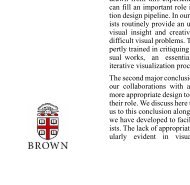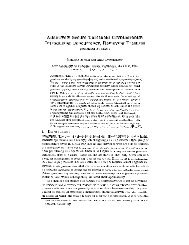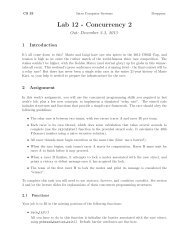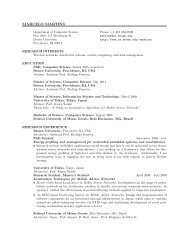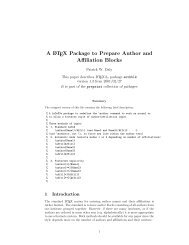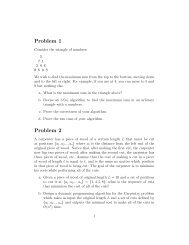AuctionMark OLTP Benchmark
AuctionMark OLTP Benchmark
AuctionMark OLTP Benchmark
Create successful ePaper yourself
Turn your PDF publications into a flip-book with our unique Google optimized e-Paper software.
<strong>AuctionMark</strong> <strong>OLTP</strong> <strong>Benchmark</strong><br />
Project Report<br />
Visawee Angkanawaraphan<br />
2/18/2011
Table of Contents<br />
1. Introduction ................................................................................................................................................................. 3<br />
2. Data Tables .................................................................................................................................................................. 4<br />
2.1 Global Tables ........................................................................................................................................................ 4<br />
2.2 User Tables ........................................................................................................................................................... 6<br />
2.3 Item Tables ............................................................................................................................................................ 7<br />
3. Stored Procedures .................................................................................................................................................. 13<br />
3.1 new-user .............................................................................................................................................................. 14<br />
3.2 new-item ............................................................................................................................................................... 14<br />
3.3 new-bid ................................................................................................................................................................. 16<br />
3.4 new-comment ..................................................................................................................................................... 18<br />
3.5 new-comment-response .................................................................................................................................. 19<br />
3.6 new-purchase ..................................................................................................................................................... 20<br />
3.7 new-feedback...................................................................................................................................................... 21<br />
3.8 get-item ................................................................................................................................................................ 22<br />
3.9 update-item ......................................................................................................................................................... 23<br />
3.10 check-winning-bids ........................................................................................................................................ 24<br />
3.11 post-auction ...................................................................................................................................................... 26<br />
3.12 get-comment ..................................................................................................................................................... 27<br />
3.13 get-user-info ..................................................................................................................................................... 28<br />
3.14 get-watched-items ........................................................................................................................................... 30<br />
2
<strong>AuctionMark</strong> <strong>OLTP</strong> <strong>Benchmark</strong><br />
1. Introduction<br />
<strong>AuctionMark</strong> benchmark is an Online Transaction Processing (<strong>OLTP</strong>) workload that simulates the activities found in<br />
a well-known auction site. This benchmark comprises of 13 tables and 14 stored procedures representing the<br />
auction site’s core transactions.<br />
There are two types of transactions in <strong>AuctionMark</strong>: (1) transactions that are initiated by a user and (2) book keeping<br />
transactions that are invoked periodically by the system. Sellers and buyers are two main user types in the system.<br />
Transaction that are related to sellers include (1) adding an item for auction, (2) updating an existing item’s<br />
information, and (3) responding to buyers’ comments and feedbacks. Buyers related transactions include (1) adding<br />
an item to watch list, (2) retrieving item’s detail, (3) placing a bid on an open auction, (4) purchasing an item, and (5)<br />
leaving comments/feedback for sellers. The system periodically invoke check-winning-bid transaction to check if any<br />
auction comes to the end, and checks the winning bid for that item.<br />
This benchmark is implemented in Java, and works with H-Store database. It is designed for scalability and flexibility<br />
(a user can configure the proportion of different transactions executed).<br />
The source code is publicly available from the H-Store repository via anonymous SVN:<br />
svn co<br />
https://database.cs.brown.edu/svn/hstore/trunk/tests/edu/brown/benchmarks/auctionmark<br />
3
2. Data Tables<br />
The tables are all named in a singular form. Each column is prefixed with an abbreviation of the table that it is a<br />
member of. Foreign key references include the abbreviation of the parent column. The only exception to this rule are<br />
those tables with more than one column referencing the same foreign key parent table (e.g.,<br />
ITEM_COMMENT.ic_u_id and ITEM_COMMENT.ic_buyer_id).<br />
2.1 Global Tables<br />
The Global Tables represent data that is not specific to one particular item or user.<br />
2.1.1 REGION<br />
Number of Records: 62<br />
Average Tuple Size: 28 bytes<br />
This table represents the geographical regions of users.<br />
Column Type Cardinality References Description<br />
r_id BIGINT<br />
- Region’s ID<br />
r_name VARCHAR String length 6 – 32 - Region’s name<br />
2.1.2 GLOBAL_ATTRIBUTE_GROUP<br />
Number of Records: 100<br />
Average Tuple Size: 36 bytes<br />
This table represents merchandises’ global attribute groups (e.g., brand, material, features).<br />
Column Type Cardinality References Description<br />
gag_id BIGINT<br />
gag_c_id BIGINT<br />
- Global attribute group’s ID<br />
CATEGORY.c_id Associated Category’s ID<br />
gag_name VARCHAR String length 6 – 32 - Global attribute group’s name<br />
4
2.1.3 GLOBAL_ATTRIBUTE_VALUE<br />
Number of Records: # GLOBAL_ATTRIBUTE_GROUP * 10<br />
Average Tuple Size: 36 bytes<br />
This table represents merchandises’ global attributes within each attribute groups (e.g., Rolex, Casio, Seiko within<br />
brand).<br />
Column Type Cardinality References Description<br />
gav_id BIGINT<br />
gav_gag_id BIGINT<br />
gav_name VARCHAR String length 6 – 32 -<br />
2.1.4 CATEGORY<br />
-<br />
Global attribute group’s<br />
ID<br />
GLOBAL_ATTRIBUTE_GROUP.gag_id Associated Category’s ID<br />
Global attribute group’s<br />
name<br />
Number of Records: 19,459<br />
Average Tuple Size: 85<br />
This table represents merchandises’ categories. Category can be hierarchical aligned using c_parent_id. The<br />
records in this table were retrieved from a well-known<br />
Column Type Cardinality References Description<br />
c_id BIGINT<br />
c_name VARCHAR<br />
c_parent_id BIGINT<br />
- Category’s ID<br />
- Category’s name<br />
CATEGORY.c_id Parent category’s ID<br />
5
2.2 User Tables<br />
2.2.1 USER<br />
Number of Records: 1,000,000<br />
Average Tuple Size: 376 bytes<br />
This table represents users of the system both sellers and buyers.<br />
Column Type Cardinality References Description<br />
u_id BIGINT<br />
- User’s ID<br />
u_rating BIGINT Integer 0 – 6 - User’s rating as a seller<br />
u_balance DOUBLE<br />
u_created TIMESTAMP<br />
- User’s balance<br />
- User’s create date<br />
u_r_id BIGINT 62 - User’s region ID<br />
u_sattr0 VARCHAR String length 16 – 64 - User’s attribute 0<br />
u_sattr1 VARCHAR String length 16 – 64 - User’s attribute 1<br />
u_sattr2 VARCHAR String length 16 – 64 - User’s attribute 2<br />
u_sattr3 VARCHAR String length 16 – 64 - User’s attribute 3<br />
u_sattr4 VARCHAR String length 16 – 64 - User’s attribute 4<br />
u_sattr5 VARCHAR String length 16 – 64 - User’s attribute 5<br />
u_sattr6 VARCHAR String length 16 – 64 - User’s attribute 6<br />
u_sattr7 VARCHAR String length 16 – 64 - User’s attribute 7<br />
6
2.2.2 USER_ATTRIBUTES<br />
Number of Records: # USER x 1.3<br />
Average Tuple Size: 62 bytes<br />
This table represents attributes of users.<br />
Column Type Cardinality References Description<br />
ua_id BIGINT<br />
ua_u_id BIGINT<br />
- User attribute’s ID<br />
USER.u_id User’s ID<br />
ua_name VARCHAR String length 5 – 32 - User attribute name<br />
ua_value VARCHAR String length 5 – 32 - User attribute value<br />
u_created TIMESTAMP<br />
2.3 Item Tables<br />
2.3.1 ITEM<br />
- Create timestamps<br />
Number of Records: # USER x 10<br />
Average Tuple Size: 395 bytes<br />
The ITEM id consists of a composite key where the lower 48-bits of the number is the USER.u id and the upper 16bits<br />
is the auction count for that user.<br />
Column Type Cardinality References Description<br />
i_id BIGINT<br />
i_u_id BIGINT<br />
i_c_id BIGINT<br />
- Item’s ID<br />
USER.u_id Seller’s ID<br />
CATEGORY.c_id Category’s ID<br />
i_name VARCHAR String length 6 – 32 - Item’s name<br />
i_description VARCHAR String length 50 – 255 - Item’s description<br />
i_user_attributes VARCHAR String length 20 – 255 -<br />
Text field for attributes defined just for<br />
this item<br />
7
Column Type Cardinality References Description<br />
i_initial_price DOUBLE<br />
i_current_price DOUBLE<br />
i_num_bids BIGINT<br />
i_num_images BIGINT<br />
i_num_global_attrs BIGINT<br />
i_start_date TIMESTAMP<br />
i_end_date TIMESTAMP<br />
i_status INT<br />
2.3.2 ITEM_IMAGE<br />
Number of Records: # ITEM x 3.21<br />
Average Tuple Size: 85 bytes<br />
This table keeps paths to the images of items in the ITEM table.<br />
- Item’s initial price<br />
- Item’s current price<br />
- Item’s number of bids<br />
- Item’s number of images<br />
- Item’s number of global attributes<br />
- Item’s bid start date<br />
- Item’s bid end date<br />
-<br />
Item’s status (0 = OPEN, 1 =<br />
WAITING_FOR_PURCHASE, 2 =<br />
CLOSED)<br />
Column Type Cardinality References Description<br />
ii_id BIGINT<br />
ii_i_id BIGINT<br />
ii_u_id BIGINT<br />
- Image’s ID<br />
ITEM.i_id Item’s ID<br />
ITEM.i_u_id Item’s user ID<br />
ii_path VARCHAR String length 20 – 100 - Image’s path<br />
8
2.3.3 ITEM_COMMENT<br />
Number of Records: # ITEM x 0.466<br />
Average Tuple Size: 180 bytes<br />
Comments of items in the ITEM table.<br />
Column Type Cardinality References Description<br />
ic_id BIGINT<br />
ic_i_id BIGINT<br />
ic_u_id BIGINT<br />
ic_buyer_id BIGINT<br />
ic_date TIMESTAMP<br />
- Comment’s ID<br />
ITEM.i_id Item’s ID<br />
ITEM.i_u_id Item’s user ID<br />
USER.u_id Item’s buyer ID<br />
- Comment’s create date<br />
ic_question VARCHAR String length 10 – 128 - Comment from buyer<br />
ic_response VARCHAR String length 10 – 128 - Response from seller<br />
2.3.4 ITEM_FEEDBACK<br />
Number of Records: # ITEM x 0.466<br />
Average Tuple Size: 180 bytes<br />
Feedbacks of items in the ITEM table.<br />
Column Type Cardinality References Description<br />
if_id BIGINT<br />
if_i_id BIGINT<br />
if_u_id BIGINT<br />
if_buyer_id BIGINT<br />
if_rating BIGINT<br />
if_date TIMESTAMP<br />
- Feedback’s ID<br />
ITEM.i_id Item’s ID<br />
ITEM.i_u_id Item’s user ID<br />
USER.u_id Item’s buyer ID<br />
- Rating given to the seller<br />
- Feedback date<br />
9
Column Type Cardinality References Description<br />
if_comment VARCHAR String length 10 – 128 - Feedback from buyer<br />
2.3.5 ITEM_BID<br />
Number of Records: # ITEM x 10.62<br />
Average Tuple Size: 64 bytes<br />
Bids of items in the ITEM table.<br />
Column Type Cardinality References Description<br />
ib_id BIGINT<br />
ib_i_id BIGINT<br />
ib_u_id BIGINT<br />
ib_buyer_id BIGINT<br />
ib_bid DOUBLE<br />
ib_max_bid DOUBLE<br />
ib_created TIMESTAMP<br />
ib_updated TIMESTAMP<br />
- Bid’s ID<br />
ITEM.i_id Item’s ID<br />
ITEM.i_u_id Item’s seller ID<br />
USER.u_id Buyer’s ID<br />
- Bid<br />
- Max bid<br />
- Bid’s create date<br />
- Bid’s update date<br />
10
2.3.6 ITEM_MAX_BID<br />
Number of Records: # ITEM x 0.76<br />
Average Tuple Size: 56 bytes<br />
The maximum bids of each item in the ITEM table.<br />
Column Type Cardinality References Description<br />
imb_i_id BIGINT<br />
imb_u_id BIGINT<br />
imb_ib_id BIGINT<br />
imb_ib_i_id BIGINT<br />
imb_ib_u_id BIGINT<br />
imb_created TIMESTAMP<br />
imb_updated TIMESTAMP<br />
2.3.7 ITEM_PURCHASE<br />
Number of Records: # ITEM x 0.026<br />
Average Tuple Size: 40 bytes<br />
Tthe purchasing records from the buyers.<br />
ITEM.i_id Item’s ID<br />
ITEM.i_u_id Item’s seller ID<br />
ITEM_BID.ib_id Bid’s ID<br />
ITEM_BID.ib_i_id Bid’s item ID<br />
ITEM_BID.ib_u_id Bid’s seller ID<br />
- Max bid create timestamps<br />
- Max bid update timestamps<br />
Column Type Cardinality References Description<br />
ip_id BIGINT<br />
ip_ib_id BIGINT<br />
ip_i_id BIGINT<br />
ip_u_id BIGINT<br />
ip_date TIMESTAMP<br />
- Purchase’s ID<br />
ITEM_BID.ib_id Bid’s ID<br />
ITEM_BID.ib_i_id Item’s ID<br />
ITEM_BID.ib_u_id Item’s seller ID<br />
- Purchase timestamps<br />
11
2.3.8 USER_ITEMS<br />
Number of Records: # ITEM x 0.026<br />
Average Tuple Size: 32 bytes<br />
The items that a user has recently purchased.<br />
Column Type Cardinality References Description<br />
ui_u_id BIGINT<br />
ui_i_id BIGINT<br />
ui_seller_id BIGINT<br />
ui_created TIMESTAMP<br />
USER.u_id User’s ID<br />
ITEM.i_id Item’s ID<br />
ITEM.i_u_id Seller’s ID<br />
- Purchase timestamps<br />
12
3. Stored Procedures<br />
The stored procedures below are executed in the following distribution except for two stored procedures; checkwinning-bid<br />
and post-auction. check-winning-bid is executed every 10 seconds, and post-auction is executed right<br />
after check-winning-bid.<br />
Stored procedures Frequency<br />
new-user 5%<br />
new-item 10%<br />
new-bid 18%<br />
new-comment 2%<br />
new-comment-response 1%<br />
new-purchase 2%<br />
new-feedback 3%<br />
get-item 40%<br />
update-item 2%<br />
get-comment 2%<br />
get-user-info 10%<br />
get-watched-item 5%<br />
13
3.1 new-user<br />
Creates a new USER record. The rating and balance are both set to zero.<br />
The benchmark randomly selects id from a pool of region ids as an input for u_r_id parameter using flat distribution.<br />
Input parameters<br />
Name Type Description<br />
u_id BIGINT The new user’s unique id<br />
u_r_id BIGINT User’s region<br />
attributes[] 8 × VARCHAR(12-64) An array of random string attributes for this user<br />
Output parameters<br />
None<br />
Pseudo code<br />
// Insert the user<br />
INSERT INTO USER (u_id, u_rating, u_balance, u_created, u_r_id, u_sattr0, u_sattr1, u_sattr2, u_sattr3, u_sattr4, u_sttar5, u_sattr6,<br />
u_sattr 7)<br />
VALUES (, 0, 0, , , , , , ,<br />
, , , );<br />
3.2 new-item<br />
Insert a new ITEM record for a user. The benchmark client provides all of the preliminary information required for the<br />
new item, as well as optional information to create derivative image and attribute records. After inserting the new<br />
ITEM record, the transaction then inserts any GLOBAL ATTRIBUTE VALUE and ITEM IMAGE. The unique identifier<br />
for each of these records is a composite 64-bit key where the lower 60-bits are the i id parameter and the upper 4bits<br />
are used to represent the index of the image/attribute. For example, if the i id is 100 and there are four items,<br />
then the composite key will be 0 100 for the first image, 1 100 for the second, and so on. After these records are<br />
inserted, the transaction then updates the USER record to add the listing fee to the seller’s balance.<br />
The benchmark randomly selects id from a pool of users as an input for u_id parameter using Gaussian distribution.<br />
A c_id parameter is randomly selected using a flat histogram from the real auction site’s item category statistic.<br />
14
Input parameters<br />
Name Type Description<br />
i_id BIGINT The new item’s unique id (0–2^60 )<br />
u_id BIGINT The seller’s user id<br />
c_id BIGINT The new item’s category id<br />
name VARCHAR The title of the new item<br />
description VARCHAR The text description of the new item<br />
initial_price DOUBLE The initial price of the new item<br />
reserve price DOUBLE The seller’s reserve selling price (can be null)<br />
buy now DOUBLE The seller’s “instance purchase” price (can be null)<br />
attributes VARCHAR Textual BLOB of user-defined attributes for the item<br />
gag_ids[] (0-16) × BIGINT List of GLOBAL ATTRIBUTE GROUP ids to include for this item<br />
gav_ids[] (0-16) × BIGINT List of GLOBAL ATTRIBUTE VALUE ids to include for this item<br />
images[] (0-16) × VARCHAR(128) List of unique image paths<br />
start_date TIMESTAMP Auction start timestamp<br />
end_date TIMESTAMP Auction end timestamp<br />
Output parameters<br />
Name Type Description<br />
i_id BIGINT The new item’s unique id<br />
i_u_id BIGINT The seller’s user id<br />
15
Pseudo code<br />
// Get attribute names and append them to the item description<br />
description = “”;<br />
for i = 0 to – 1<br />
__description += SELECT gag_name + ” ” + gav_name FROM GLOBAL_ATTRIBUTE_GROUP, GLOBAL_ATTRIBUTE_VALUE<br />
______________WHERE gav_id = gav_ids[i] AND gav_gag_id = gag_ids[i] AND gav_gag_id = gag_id;<br />
// Insert the item<br />
INSERT INTO ITEM (i_id, i_u_id, i_c_id, i_name, i_description, i_user_attributes, i_initial_price, i_num_bids, i_num_images,<br />
i_num_global_attrs, i_start_date, i_end_date)<br />
VALUES (, , , , , , , 0, , ,<br />
, );<br />
// Add item images<br />
for i = 0 to – 1<br />
__ii_id = (i
Name Type Description<br />
u_id BIGINT The seller’s user id<br />
i_buyer_id BIGINT The buyer’s user id<br />
bid DOUBLE The amount the buyer bids on the item<br />
maxBid DOUBLE The maximum amount the buyer bids on the item<br />
Output parameters<br />
Name Type Description<br />
ib_id BIGINT The new bid’s id<br />
Pseudo code<br />
// Increment the number of bids<br />
UPDATE ITEM<br />
SET i_num_bids = i_num_bids + 1<br />
WHERE i_id = AND i_u_id = AND i_status = 0;<br />
ib_id = SELECT MAX(ib_id) + 1 FROM ITEM_BID WHERE ib_i_id = AND ib_u_id = ;<br />
imb_ib_id = SELECT imb_ib_id FROM ITEM_MAX_BID WHERE imb_i_id = AND imb_u_id = ;<br />
if imb_ib_id is not null then<br />
__// If we have an existing max bid, then we need to figure out whether we are<br />
__// the new highest bidder or if the existing one just has their max_bid bumped up<br />
__current_bid, current_max_bid = SELECT ib_bid, ib_max_bid<br />
____________________________FROM ITEM_BID<br />
____________________________WHERE ib_id = AND ib_i_id = AND ib_u_id = ;<br />
__newBidWin = false;<br />
__if maxBid > current_max_bid then<br />
____newBidWin = true<br />
____if bid < current_max_bid then<br />
______bid = current_max_bid<br />
____endif<br />
__else<br />
____if bid > current_bid then<br />
______UPDATE ITEM_BID<br />
______SET ib_bid = <br />
17
______WHERE ib_id = AND ib_i_id = AND ib_u_id = ;<br />
____endif<br />
__endif<br />
__INSERT INTO ITEM_BID (ib_id, ib_i_id, ib_u_id, ib_buyer_id, ib_bid, ib_max_bid, ib_created, ib_updated)<br />
__VALUES (, , , , , , , );<br />
__if newBidWin == true then<br />
____UPDATE ITEM_MAX_BID<br />
____SET imb_ib_id = ,<br />
____imb_ib_i_id = ,<br />
____imb_ib_u_id = ,<br />
____imb_updated = <br />
____WHERE imb_i_id = AND imb_u_id = ;<br />
__endif<br />
else<br />
__// There is no existing max bid record, therefore we can just insert ourselves<br />
__INSERT INTO ITEM_BID (ib_id, ib_i_id, ib_u_id, ib_buyer_id, ib_bid, ib_max_bid, ib_created, ib_updated)<br />
__VALUES (, , , , , , , );<br />
__INSERT INTO ITEM_MAX_BID (imb_i_id, imb_u_id, imb_ib_id, imb_ib_i_id, imb_ib_u_id, imb_created, imb_updated)<br />
__VALUES (, , , , , , );<br />
endif<br />
3.4 new-comment<br />
A potential buyer posts a question/comment about a seller’s item. Each transaction inserts a new ITEM COMMENT<br />
record.<br />
The benchmark randomly selects item from a pool of items that are in CLOSED status using flat distribution. It then<br />
extracts i_id, seller_id, and buyer_id from the item and associated winning bid as inputs to this stored procedure.<br />
Input parameters<br />
Name Type Description<br />
i_id BIGINT The item that the potential buyer is commenting on<br />
seller_id BIGINT The seller’s user id<br />
buyer_id BIGINT The potential buyer’s user id<br />
question VARCHAR(128) The new question posted for the item<br />
18
Output parameters<br />
Name Type Description<br />
ic_id BIGINT The new comment’s id<br />
Pseudo code<br />
INSERT INTO ITEM_COMMENT (ic_id, ic_i_id, ic_u_id, ic_buyer_id, ic_date, ic_question)<br />
VALUES (<br />
(SELECT MAX(ic_id) FROM ITEM_COMMNET WHERE ic_i_id = AND ic_u_id = ) + 1,<br />
i_id, buyer_id, , question);<br />
3.5 new-comment-response<br />
The seller responds to an open question/comment created by new-comment-response.<br />
The benchmark randomly selects comment from a pool of comments by users using flat distribution. It then uses<br />
i_id, i_c_id, and seller_id from the selected comment as inputs to this stored procedure.<br />
Input parameters<br />
Name Type Description<br />
i_id BIGINT The item<br />
i_c_id BIGINT The item comment record that the seller is replying to<br />
seller_id BIGINT The seller’s user id<br />
response VARCHAR(128) The response to the existing comment/question<br />
Output parameters<br />
None<br />
19
Pseudo code<br />
UPDATE ITEM_COMMENT<br />
SET ic_response = <br />
WHERE ic_id = AND ic_i_id = AND ic_u_id = <br />
3.6 new-purchase<br />
The buyer purchases the item for a previously won auction. This stored procedure checks first if the input bid is the<br />
winning bid. It then inserts a record to the purchase table, and changes item’s status to CLOSED.<br />
The benchmark randomly selects item from a pool of items that are in WAITING_FOR_PURCHASE status using flat<br />
distribution. It then gets a wining bid of that item, and extracts ib_id, i_id, u_id, and buyer_id as inputs to this stored<br />
procedure.<br />
Input parameters<br />
Name Type Description<br />
ib_id BIGINT The winning bid ID<br />
i_id BIGINT The ID of the purchasing item<br />
u_id BIGINT The seller’s user ID<br />
buyer_id BIGINT The buyer’s user ID<br />
Output parameters<br />
Name Type Description<br />
ip_id BIGINT The new purchase id<br />
ip_ib_id BIGINT The associated bid’s id<br />
ip_ib_i_id BIGINT The associated item’s id<br />
u_id BIGINT The associated seller’s user id<br />
ip_ib_u_id BIGINT The associated buyer’s user id<br />
20
Pseudo code<br />
imb_ib_id, imb_ib_i_id, imb_ib_u_id = SELECT imb_ib_id, imb_ib_i_id, imb_ib_u_id<br />
________________________________FROM ITEM_MAX_BID<br />
________________________________WHERE imb_i_id = AND imb_u_id = ;<br />
ib_buyer_id = SELECT ib_buyer_id<br />
____________FROM ITEM_BID<br />
____________WHERE ib_id = AND ib_i_id = AND ib_u_id = ;<br />
// Validate inputs<br />
if ib_id != imb_ib_id || buyer_id != ib_buyer_id then<br />
__throws error<br />
endif<br />
ip_id = (SELECT MAX(ip_id) FROM ITEM_PURCHASE WHERE ip_ib_id = AND ip_ib_i_id = AND ip_ib_u_id =<br />
) + 1;<br />
// Insert a new purchase<br />
INSERT INTO ITEM_PURCHASE (ip_id, ip_ib_id, ip_ib_i_id, ip_ib_u_id, ip_date)<br />
VALUES(, , , , );<br />
// Update item status to closed (i_status = 2)<br />
UPDATE ITEM<br />
SET i_status = 2<br />
WHERE i_id = AND i_u_id = ;<br />
3.7 new-feedback<br />
The buyer adds a seller feedback for a previously won auction. The rating is either -1, 0, or 1 and is added to the<br />
USER.u rating attribute.<br />
The benchmark randomly selects item from a pool of items that are in CLOSED status using flat distribution. It then<br />
extracts i_id, seller_id, and buyer_id from the item and associated winning bid as inputs to this stored procedure.<br />
Input parameters<br />
Name Type Description<br />
i_id BIGINT The purchased item<br />
seller_id BIGINT The seller’s user id<br />
buyer id BIGINT The potential buyer’s user id<br />
rating BIGINT [−1, 0, 1]<br />
21
Name Type Description<br />
comment VARCHAR(128) An optional comment for the seller<br />
Output parameters<br />
Name Type Description<br />
if_id BIGINT The new feedback’s id<br />
Pseudo code<br />
if_id = (SELECT MAX(if_id) FROM ITEM_FEEDBACK WHERE if_i_id = AND if_u_id = ) + 1;<br />
INSERT INTO ITEM_FEEDBACK (if_id, if_i_id, if_u_id, if_buyer_id, if_rating, if_date, if_comment)<br />
VALUES(, , , , , , );<br />
3.8 get-item<br />
Get item information. Returns all of the attributes for a particular item.<br />
The benchmark randomly selects item from a pool of items that are in OPEN status using flat distribution. It then<br />
extracts i_id and i_u_id from the item as inputs to this stored procedure.<br />
Input parameters<br />
Name Type Description<br />
i_id BIGINT The id of the item to retrieve<br />
i_u_id BIGINT The seller’s user id for this item<br />
Output parameters<br />
Name Type Description<br />
i_id BIGINT The new item’s unique id<br />
22
Name Type Description<br />
i_u_id BIGINT The seller’s user id<br />
i_initial_price DOUBLE The initial price of this item<br />
i_current_price DOUBLE Current price of this item<br />
Pseudo code<br />
// Get the item<br />
SELECT i_id, i_u_id, i_initial_price, i_current_price<br />
FROM ITEM<br />
WHERE i_id = AND i_u_id = AND i_status = 0;<br />
3.9 update-item<br />
The buyer modifies an existing auction that is still available. The transaction will just update the description of the<br />
auction. A small percentage of the transactions will be for auctions that are uneditable; when this occurs, the<br />
transaction will abort.<br />
The benchmark randomly selects item from a pool of items that are in OPEN status using flat distribution. It then<br />
extracts i_id and i_u_id from the item as inputs to this stored procedure.<br />
Input parameters<br />
Name Type Description<br />
i_id BIGINT The id of the item to modify<br />
i_u_id BIGINT The seller’s user id for this item<br />
Description VARCHAR(255) The new description for the item<br />
Output parameters<br />
None<br />
23
Pseudo code<br />
UPDATE ITEM<br />
SET i_description = <br />
WHERE i_id = AND i_u_id = <br />
3.10 check-winning-bids<br />
This stored procedure is called once a minute to examine whether any auctions ended within the last 60 seconds. It<br />
returns a list of ITEM.i ids of the auctions that need to be processed. This is a broadcast transaction that must be<br />
executed on all nodes.<br />
Input parameters<br />
Name Type Description<br />
startTime TIMESTAMP Start time of the duration that we want to check for ended auctions<br />
endTime TIMESTAMP End time of the duration that we want to check for ended auctions<br />
Output parameters<br />
An array of due item objects each containing the following fields.<br />
Name Type Description<br />
i_id BIGINT Item’s id<br />
i_u_id BIGINT Seller’s id<br />
i_status BIGINT Item’s status<br />
imb_ib_id BIGINT The winning bid’s id (Can be null if there is no winning bid on this item)<br />
ib_buyer_id BIGINT The buyer’s id (Can be null if there is no winning bid on this item)<br />
24
Pseudo code<br />
// Get all due items that are still in status OPEN<br />
dueItems = SELECT i_id, i_u_id, i_status<br />
_________FROM ITEM<br />
_________WHERE i_start_date BETWEEN AND AND i_status = 0<br />
_________LIMIT 100;<br />
// For each item, check if there is a winning bid<br />
for each dueItem in dueItems<br />
__itemId = dueItem.i_id<br />
__userId = dueItem.i_u_id<br />
__itemStatus = dueItem.i_status<br />
__maxBidId = SELECT imb_ib_id<br />
____________FROM ITEM_MAX_BID<br />
____________WHERE imb_i_id = AND imb_u_id = ;<br />
__if maxBidId is not null then<br />
____// Found wining bid, retrieve buyer of the winning bid<br />
____buyerId = SELECT ib_buyer_id<br />
____________FROM ITEM_BID<br />
____________WHERE ib_id = AND ib_i_id = AND ib_u_id = ;<br />
____userItem = {itemId, userId, itemStatus, maxBidId, buyerId}<br />
__else<br />
____userItem = {itemId, userId, itemStatus, null, null}<br />
__endif<br />
__result.add(userItem);<br />
endfor<br />
return result<br />
25
3.11 post-auction<br />
Each transaction performs post-processing of a given closed auction items. This stored procedure goes through<br />
each item and update the item status. If there is no bid for an item, this stored procedure changes the item’s status<br />
to closed. Otherwise, the status is changed to waiting-for-purchase, and a new record is inserted to the USER_ITEM<br />
table. All IDs of the same item across fields must be on the same array index. This transaction is invoked<br />
immediately after check-winning-bid if check-winning-bid finds due items.<br />
Input parameters<br />
Name Type Description<br />
i_ids Arrays of BIGINT The items’ IDs<br />
seller_ids Arrays of BIGINT The sellers’ IDs of the items<br />
buyer_ids Arrays of BIGINT The buyers’ IDs of the items<br />
ib_ids Arrays of BIGINT The bids’ IDs of the items<br />
Output parameters<br />
Name Type Description<br />
closed BIGINT The number of CLOSED items processed<br />
waiting BIGINT The number of WAITING_FOR_PURCHASE items processed<br />
Pseudo code<br />
// Go through each item and update the item status<br />
// We’ll also insert a new USER_ITEM record as needed<br />
for i = 0 to i_ids.length – 1<br />
__ib_id = ib_ids[i]<br />
__i_id = i_ids[i]<br />
__seller_id = seller_ids[i]<br />
__buyer_id = buyer_ids[i]__<br />
// No bid on this item – set status to close (i_status = 2)<br />
__if ib_id is null then<br />
____UPDATE ITEM<br />
____SET i_status = 2<br />
____WHERE i_id = AND i_u_id = ;<br />
__// Has bid on this item – set status to wait for purchase (i_status = 1)<br />
__else<br />
26
____UPDATE ITEM<br />
____SET i_status = 1<br />
____WHERE i_id = AND i_u_id = ;<br />
____INSERT INTO USER_ITEM (ui_u_id, ui_i_id, ui_i_u_id, ui_created)<br />
____VALUES(, , , );<br />
__endif<br />
endfor<br />
3.12 get-comment<br />
Get all item comments of a seller.<br />
The benchmark randomly selects id from a pool of sellers who has items in CLOSED status as a seller_id parameter<br />
using flat distribution.<br />
Input parameters<br />
Name Type Description<br />
seller_id BIGINT The seller’s user ID<br />
Output parameters<br />
An array of comments each containing every field in ITEM_COMMENT table.<br />
Pseudo code<br />
SELECT * FROM ITEM_COMMENT<br />
WHERE ic_u_id = AND ic_response IS NULL;<br />
27
3.13 get-user-info<br />
Get a user’s items as a seller or a buyer. This stored procedure also retrieves items’ feedbacks if specify. The<br />
get_seller_items, get_buyer_items, and get_feedback must be either 0 or 1. If get_seller_items and<br />
get_buyer_items are 1 at the same time, this stored procedure will retrieve all items of a user as a seller.<br />
The benchmark randomly selects id from a pool of sellers who has items in OPEN status as a u_id parameter using<br />
flat histogram.<br />
Input parameters<br />
Name Type Description<br />
u_id BIGINT The ID of the user<br />
get_seller_items BIGINT 1 if get user items as a seller<br />
get_buyer_items BIGINT 1 if get user items as a buyer<br />
get_feedback BIGINT 1 if want to include items’ feedback in the response<br />
Output parameters<br />
A user object containing every field in USER table.<br />
An array of item objects each having the following fields.<br />
Name Type Description<br />
i_id BIGINT Item’s id<br />
i_u_id BIGINT Seller’s id<br />
i_name VARCHAR Item’s name<br />
i_current_price DOUBLE Item’s current price<br />
i_end_date TIMESTAMP Item’s auction end date<br />
i_status INT Item’s status<br />
An array of item feedback objects each having the following fields.<br />
28
Name Type Description<br />
if_rating BIGINT Rating of the item<br />
if_comment VARCHAR Feedback of the item<br />
if_date TIMESTAMP Date of the feedback<br />
i_id BIGINT Item’s id<br />
i_u_id BIGINT Seller’s id<br />
i_name VARCHAR Item’s name<br />
i_end_date TIMESTAMP Item’s auction end date<br />
i_status INT Item’s status<br />
u_id BIGINT Seller’s id<br />
u_rating BIGINT Seller’s rating<br />
u_sattr0 VARCHAR Seller’s user attribute 0<br />
u_sattr1 VARCHAR Seller’s user attribute 1<br />
Pseudo code<br />
user_results = SELECT u_id, u_rating, u_balance, u_created, u_sattr0, u_sattr1, u_sattr2, u_sattr3, u_sattr4, r_name<br />
____________FROM USER, REGION<br />
____________WHERE u_id = AND u_r_id = r_id;<br />
if get_seller_items == 1 || get_buyer_items == 1 then<br />
__if get_seller_items == 1 then<br />
____item_results = SELECT i_id, i_u_id, i_name, i_current_price, i_end_date, i_status<br />
________________FROM ITEM<br />
________________WHERE i_u_id = <br />
________________ORDER BY i_end_date ASC LIMIT 20;<br />
__else if get_buyer_items == 1 then<br />
____item_results = SELECT i_id, i_u_id, i_name, i_current_price, i_end_date, i_status<br />
________________FROM USER_ITEM, ITEM<br />
________________WHERE ui_u_id = AND ui_i_id = i_id AND ui_i_u_id = i_u_id<br />
________________ORDER BY i_end_date ASC LIMIT 10;<br />
__endif<br />
29
__if get_feedback == 1 then<br />
____feedback_results = SELECT if_rating, if_comment, if_date, i_id, i_u_id, i_name, i_end_date, i_status, u_id, u_rating, u_sattr0,<br />
u_sattr1<br />
____________________FROM ITEM_FEEDBACK, ITEM, USER<br />
____________________WHERE if_buyer_id = AND if_i_id = i_id AND if_u_id = i_u_id AND if_u_id = u_id ” +<br />
____________________ORDER BY if_date DESC LIMIT 10;<br />
__endif<br />
endif<br />
return user_results, item_results, feedback_results<br />
3.14 get-watched-items<br />
Gets all watched items of a buyer.<br />
The benchmark randomly selects id from a pool of users as a u_id parameter using Gaussian distribution.<br />
Input parameters<br />
Name Type Description<br />
u_id BIGINT The buyer’s user ID<br />
Output parameters<br />
An array of user watched items each having the following fields.<br />
Name Type Description<br />
uw_u_id BIGINT User’s id<br />
i_id BIGINT Item’s id<br />
i_u_id BIGINT Seller’s id<br />
i_name VARCHAR Item’s name<br />
i_current_price DOUBLE Item’s current price<br />
i_end_date TIMESTAMP Item’s auction end date<br />
i_status INT Item’s status<br />
30
Name Type Description<br />
uw_created TIMESTAMP Watched item create date<br />
Pseudo code<br />
SELECT uw_u_id, i_id, i_u_id, i_name, i_current_price, i_end_date, i_status, uw_created<br />
FROM USER_WATCH, ITEM<br />
WHERE uw_u_id = AND uw_i_id = i_id AND uw_i_u_id = i_u_id<br />
ORDER BY i_end_date ASC LIMIT 25<br />
31



